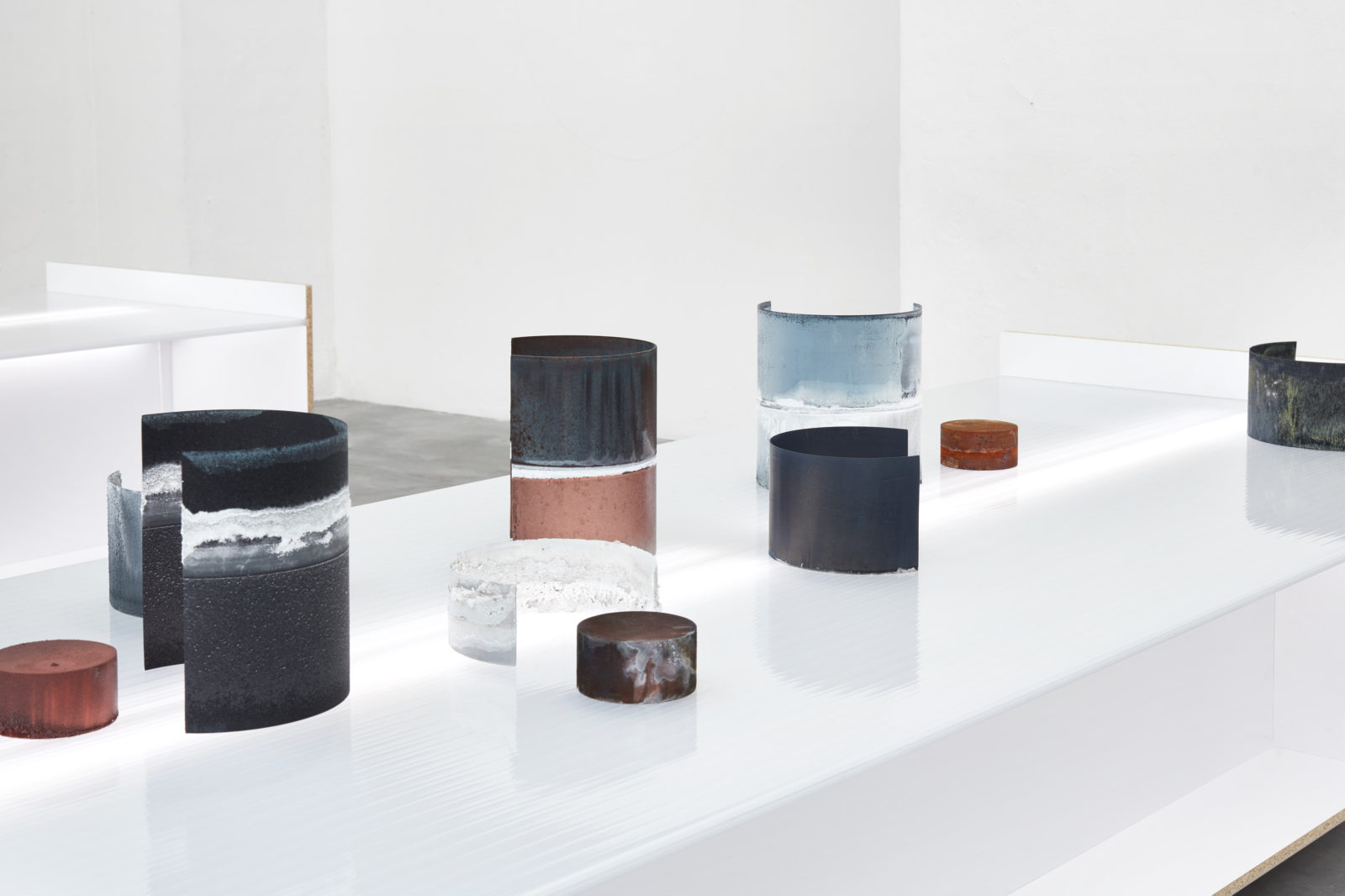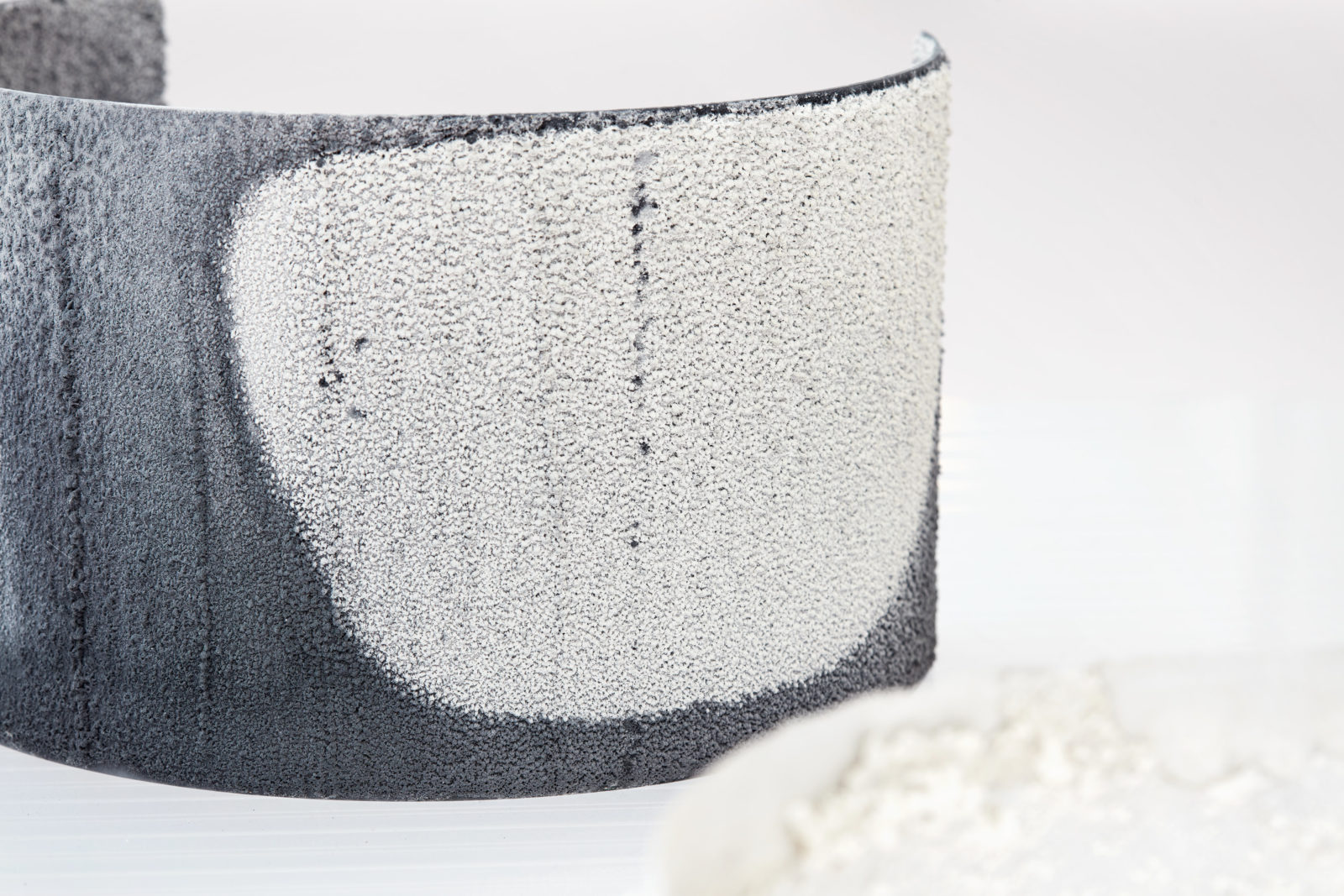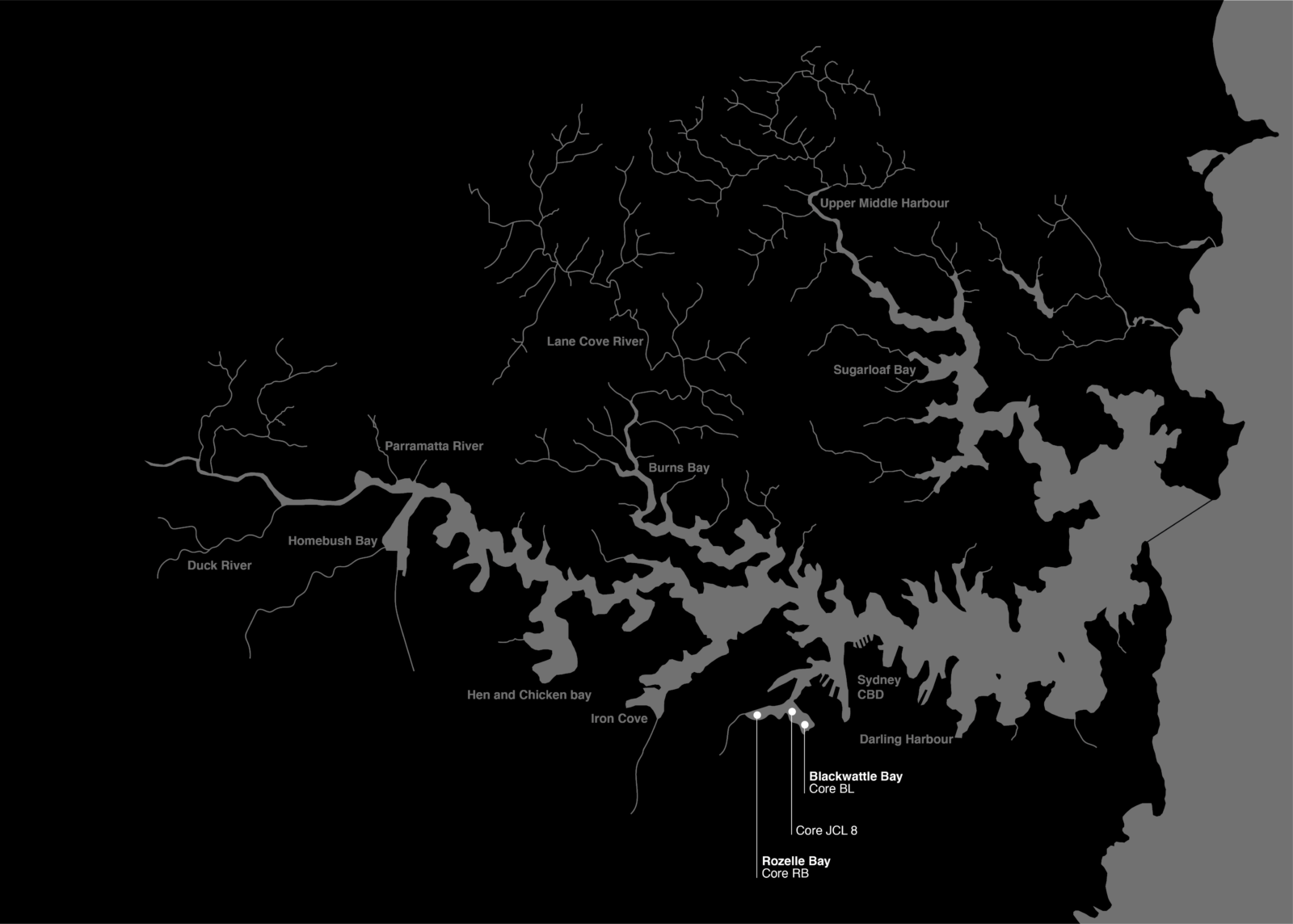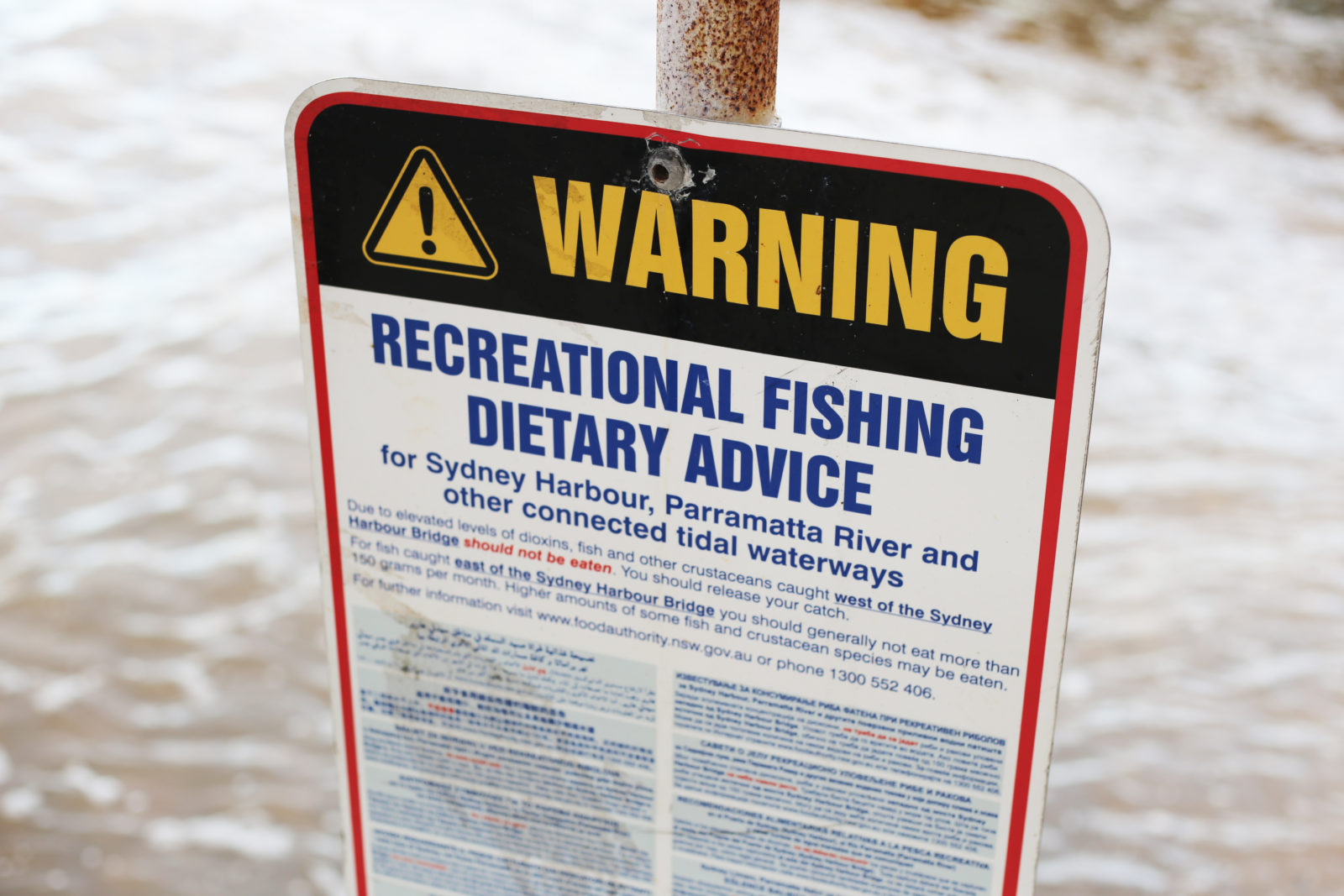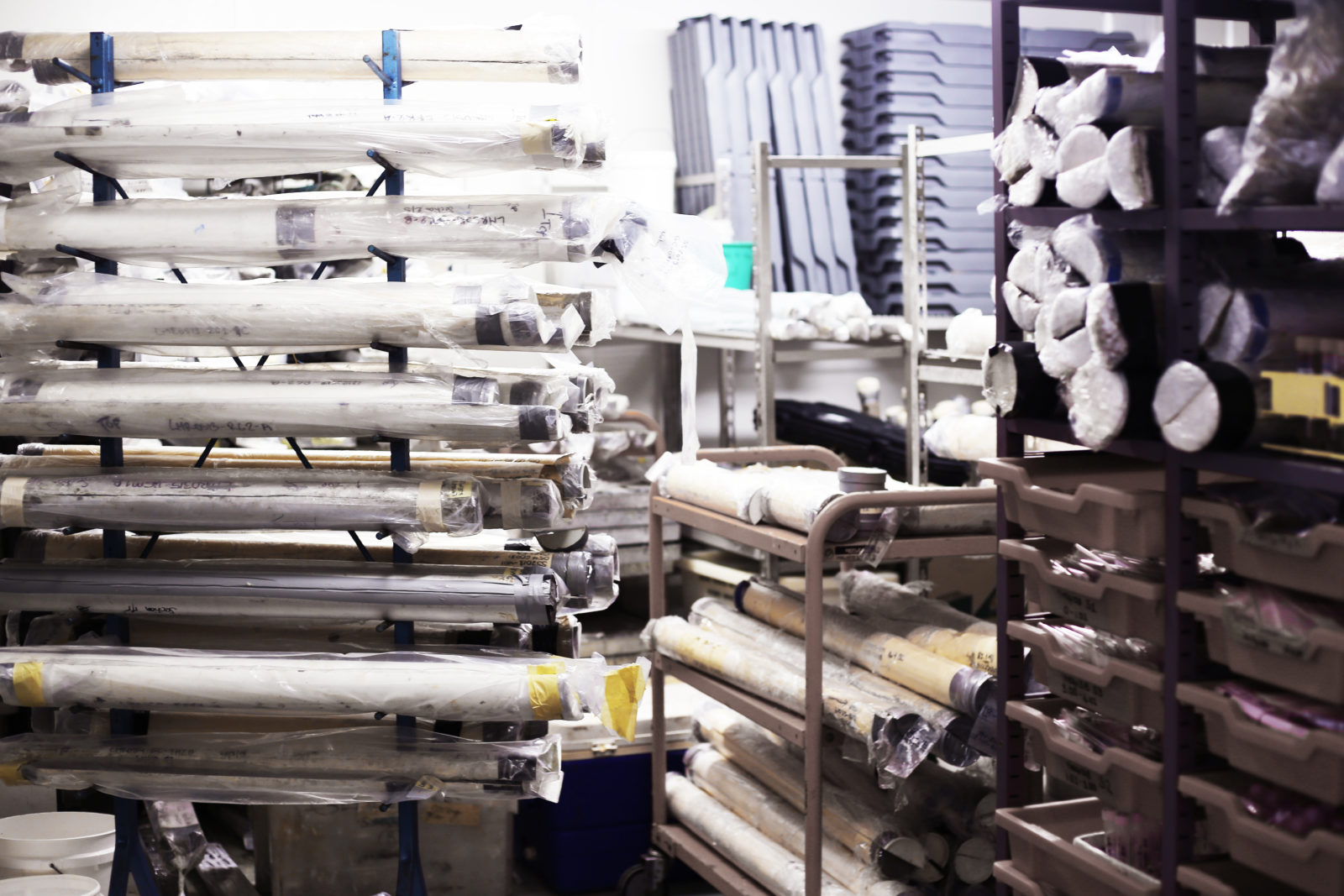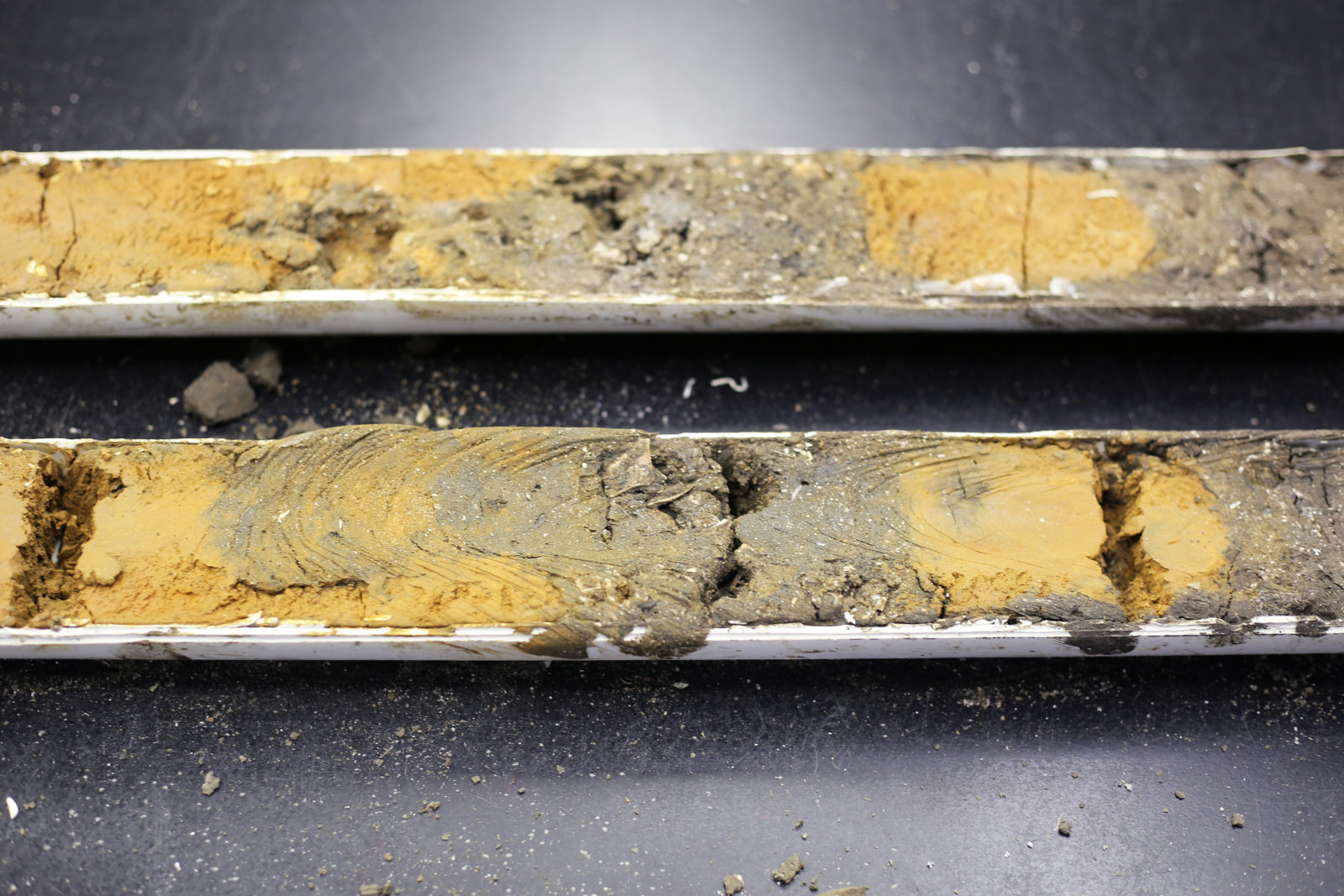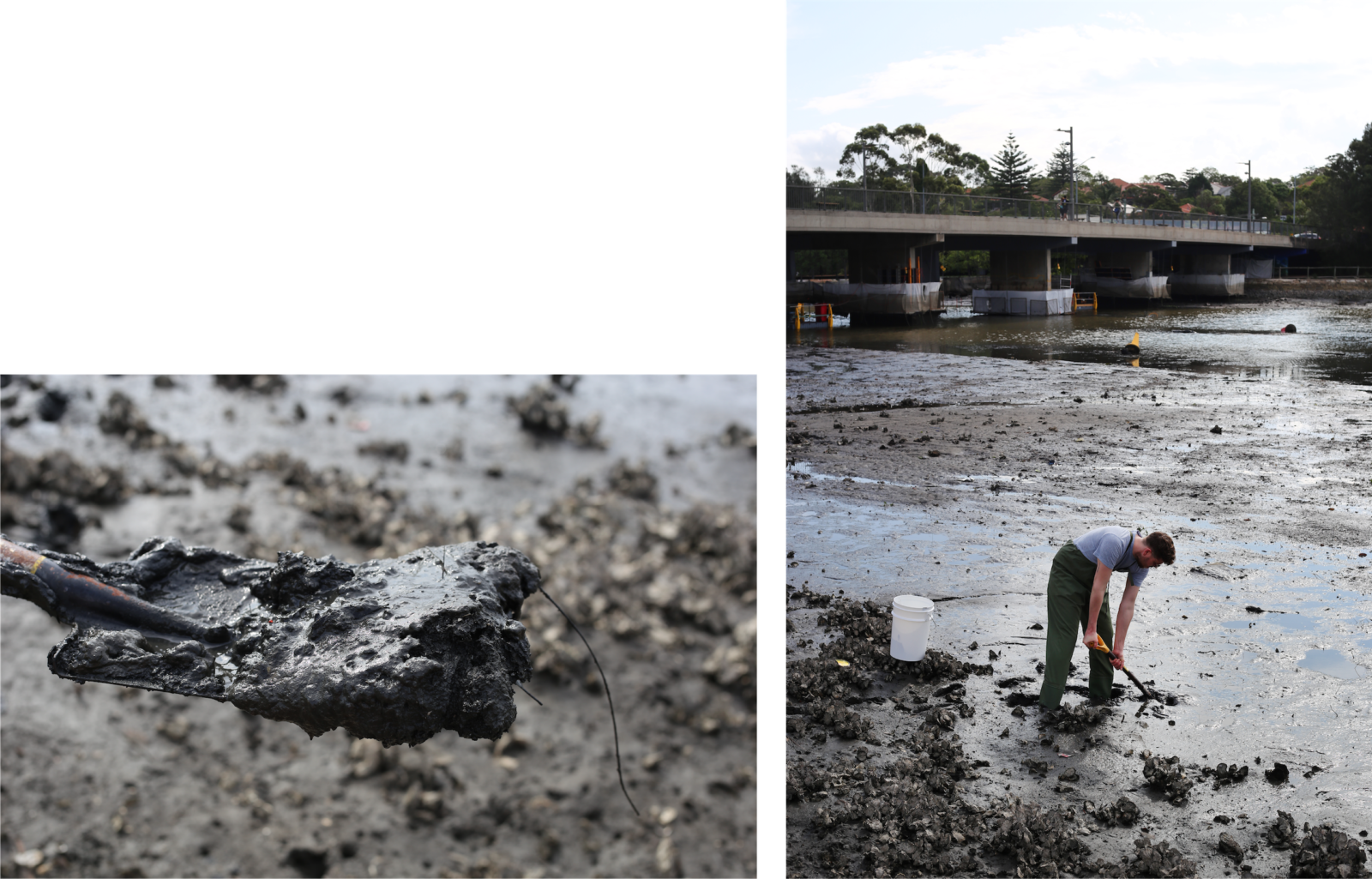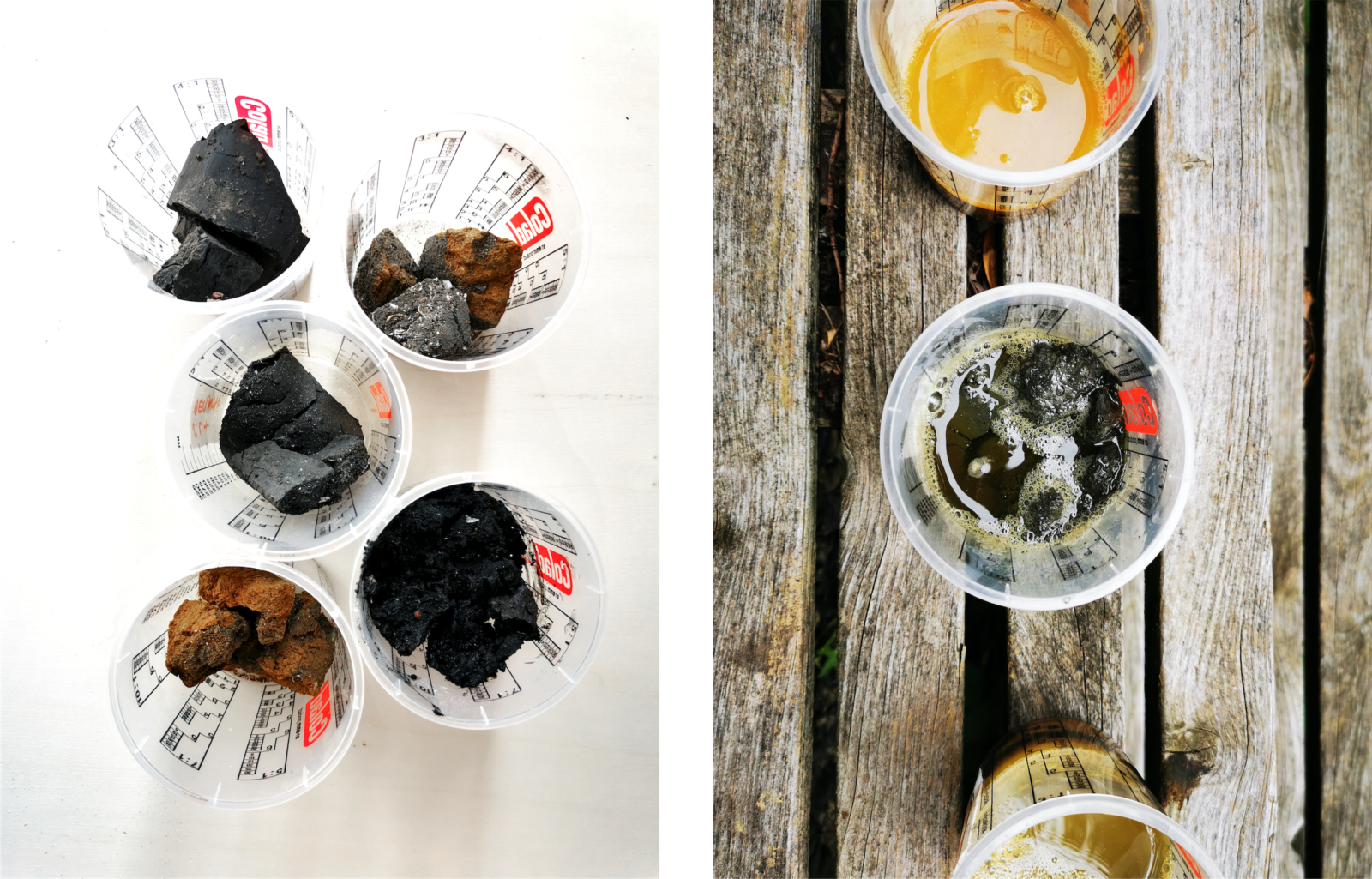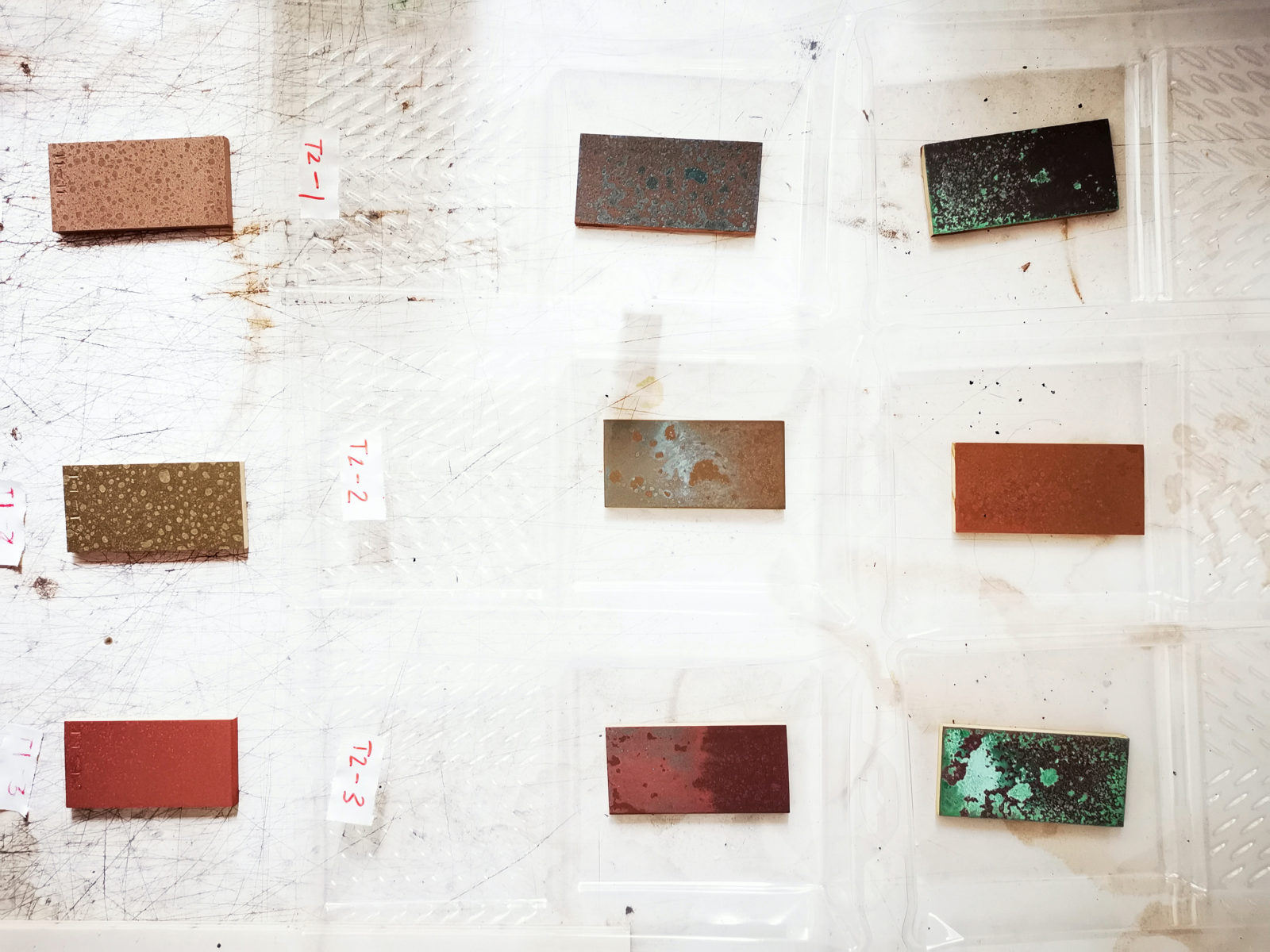Visualizing the Vibrant Materiality of Place
Artistic experiments on polluted sediment and the anthropogenic evolution of minerals
What insights can artistic research data produce in the scientific analysis of the natural archive? In practicing aesthetic attunement to material intra-actions between nonhuman entities, artist and researcher Xandra van der Eijk addresses the value of artmaking with, through, and between the materiality of place. Visualizing anthropogenic markers present in the sediment samples of Sydney Harbour, one of the most polluted estuaries in the world, she undertakes a hybridization of artistic and scientific method.
In 2017, a scientific paper about 208 new minerals that were being added to the record of the International Mineralogical Association (IMA) gained wide publicity.1 Within the realm of mineralogy, the paper insisted, anthropogenic activity is—unintentionally—immensely boosting evolutionary development. In the Earth’s 4.6-billion-year history, there have been multiple stages of mineral evolution that can be divided into three eras or ten stages.2 Now, according to Hazen and his colleagues, anthropogenic activity can be seen as entering a new, eleventh stage—and possibly even a new, fourth, era.3 Though there is currently no inventory or formal recognition, the number of anthropogenically reproduced earth minerals, alloys, and other synthetic minerals could easily run into the thousands.4 In comparison, before the human modification of terrestrial mineral composition in the process of exploitation, only 4,000 were catalogued by the IMA.
To qualify as a legitimate species and enter the IMA’s database, a mineral should be “a natural occurring solid that has been formed by geological processes, either on Earth or in extraterrestrial bodies.”5 The IMA’s acknowledgement of 208 new minerals was based on the careful consideration of what is “natural,” leading the association to recognize specimens that were “reported either exclusively as inadvertent byproducts of human activities, or as inadvertent human-mediated phases in some cases.”6 In other words, these minerals occurred accidentally, in an environment altered by humans yet not specifically designed for mineral evolution, as would be the case for synthetic mineral production in a lab. The newly recognized minerals grow following the same geological principles of prior evolutionary stages, with no direct human interference, yet in landscapes filled with the unintended consequences of industrialization and extractivism. The practices from which they result—mining, metal-making, (chemical) waste storage, and waste dumping—are messy and leaky, and their lifetimes and afterlives are often left underestimated, unconsidered, or left for (the often marginalized) others to deal with.
Learning of the emergence of these new minerals sparks the imagination of another world, as a “mineral reality” unfolds on the foundation of the ongoing large-scale redistribution of matter. The visualization of the precious, delicate new structures, colors, and textures sprouting within landfills, abandoned mines, or forgotten corners of foundries invites us to think beyond an anthropogenic perspective and timeframe, and evokes a reflection on our responsibility and legacy. The mineral emergence furthermore signifies the unintended and ongoing reaction between materialities that without human intervention never would have been exposed to each other. Its narrative and aesthetic power can offer an entry point to some of the confrontational truths of the proposed Anthropocene, in particular on the question of how scientific data is used to create meaning, and in general the practice of geological and stratigraphical research.
Prototyping the mineral evolution
Future Remnants presented with Dutch Invertuals at Milan Design Week. Photo courtesy Dutch Invertuals/Ronald Smits. Alexandra van der Eijk © All rights reserved
A newspaper article on mineral evolution inspired my artistic research project titled Future Remnants (2018) that came to life for an exhibition with the design collective Dutch Invertuals. Creating new work once a year, each member of the collective responds artistically to the thematic framing of a subject. In 2018, the subject was “Mutant Matter”—a good fit for thinking through the idea of rapid mineral evolution unfolding in capitalist ruins. Future Remnants consisted of a series of material experiments that structurally tested the effects of exposing everyday household chemicals, such as all-purpose cleaning products, tarnish remover, and drain unblocker, to different kinds of metal. For obvious reasons, the active component of most household chemicals is rarely higher than 10 percent of the total solution, and more often lies in the range of 3–5 percent. Since these products are handled daily, in and around the house, one might not expect that they can cause mineral growth—and certainly not easily and in abundance. Yet this was the result from following a simple hands-on methodology, taking different household chemicals and brands and structurally exploring different means of application to a selection of metals (all available at a regular hardware store). The effects of a recipe could be repeated, though not always, and they were never the precisely same, which speaks to the precarious development of minerals and their dependence on exactly the right environmental circumstances. The experiment recipes brought forth “mineral characters” demonstrated in the form of a series of simple circular objects presented during the Milan Design Week of 2018.
Future Remnants presented with Dutch Invertuals at Milan Design Week. Photo courtesy Dutch Invertuals/Ronald Smits, Alexandra van der Eijk © All rights reserved
Future Remnants presented with Dutch Invertuals at Milan Design Week. Photo courtesy Dutch Invertuals/Ronald Smits, Alexandra van der Eijk © All rights reserved Future Remnants presented with Dutch Invertuals at Milan Design Week. Photo courtesy Dutch Invertuals/Ronald Smits, Alexandra van der Eijk © All rights reserved
Since the concept of mineral evolution is abstract, it emerges in places with either limited or no accessibility, and since it is difficult to predict where new minerals will arise, it is hard to imagine the powerful material interactions at work in this evolutionary process. Indeed, understanding any evolutionary process as a movement in time requires a way of unpacking its complexity and multiplicity. The artistic process can play an important role in re-enacting processes that take place in a natural environment, such as the ones that allow new minerals to grow. Future Remnants showed how speculation, re-enactment, and material experimentation can lead to a tangible case study of mineral emergence tied to anthropogenic factors. Spectators often could not believe the violent effects of simple cleaning products, and the likelihood that these everyday substances would end up in an environment where they could react with other materialities was instantly clear to them. Though attractive to touch due to the universal appeal of shiny, glittering crystal surfaces, the aftertaste left by learning of their chemical origin evoked questions of toxicity and health, in both the body and the environment. The objects thus not only created a mental bridge to consider longer-term mineral evolution and the role played by industrialization and waste production, they also raised the important questions of responsibility and legacy.
Attuning to the storied matter of the Sydney estuary
In 2019, Lou Weiss, curator of Broached Commissions, offered the opportunity to pitch for a public artwork in Sydney, Australia. Building on the Future Remnants project, the research into the surroundings of the proposed location of the artwork, the harbor area, soon revealed a possible focus on pollution in the sediments of Sydney estuary, which is one of the most modified and polluted estuaries in the world.7 What followed was a case study and experimentation process expanding on the thoughts about mineral evolution and toxicity. It provided a unique opportunity for engaging directly with the toxic materiality that lies submerged in the stratigraphy of the seafloor of Sydney estuary, particularly that of Blackwattle Bay.
A short history of Sydney Harbour
Sydney estuary and the location of cores discussed in this contribution. Map courtesy Sacha van den Haak
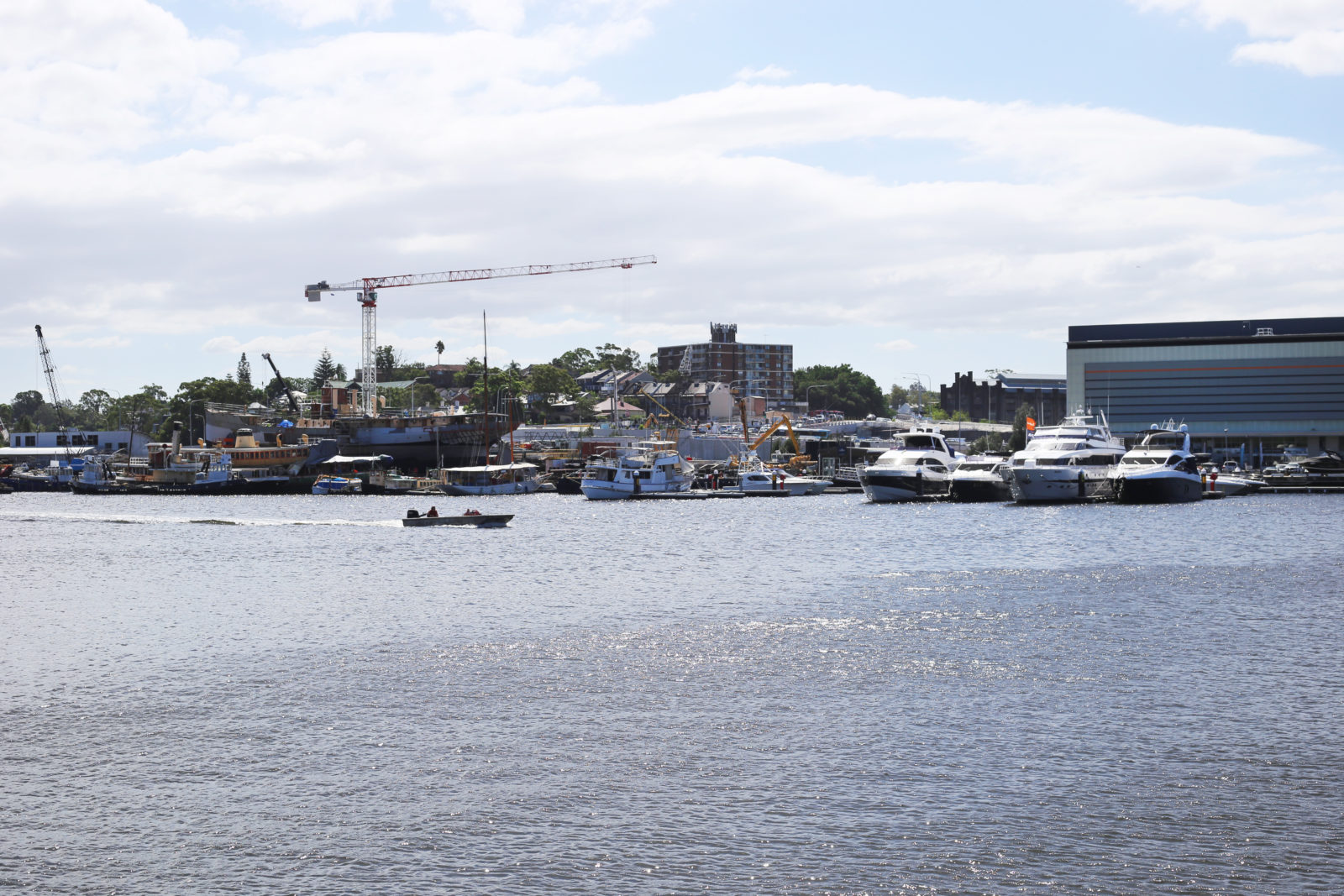
With the colonization of Port Jackson by the British in 1787, the geological record of what is now known as Sydney estuary was about to change. Until this date, evidence of human presence in the geological record is hard to find and consists primarily of shell middens, accumulations of fish bones, shells, ash, and coal deposited by Australia’s First Nation peoples who have inhabited the continent for over 40,000 years. This changed almost immediately with the establishment of the first colonial settlement, which set to work cutting the trees and clearing the land for agriculture. With an increasing number of new settlers arriving in the following years, the settlements rapidly expanded and from the 1800s onwards industrialization took hold all along the banks of Sydney estuary.8
Within the estuary, Blackwattle Bay was one of the places that became most heavily industrialized. Home to Gadigal and Wangal people, it consisted of an ecologically rich, swampy area of mudflats, mangrove forests, and salt marshes, abundant in life such as oysters, mussels, crabs, turtles, and octopus. The shorelines were occupied by an open sandstone forest, and fresh water was supplied from Blackwattle Creek. Industry initially was driven by the needs of the settlement and consisted of tanneries and abattoirs, swiftly followed by metal foundries, copper smiths, and paint manufacturers. Without regulations in place, any waste streams were directly washed into the swamp, resulting in a rapid deterioration of the natural environment. Within a matter of time, the Bay was extremely foul, calling into action decision making around regulation policies, which came into effect in 1842. Although these regulations soon proved effective, particularly by relocating polluting industries to other areas, the sediment was already irreversibly polluted.
Over the next century, steam power and the introduction of railways and bridges accelerated growth and urban development in different parts of Sydney Harbour. Around the end of the century, its industries included chemical and metal production, textile fabrication and dye processes, boat building, oil refinery, and heavy electrical equipment production. Relying on the water for transportation, industry occupied much of the waterfront, inevitably leading to runoff, leaks, or plain dumping of waste. After the Second World War, land reclamation not only led to alteration of the estuary; it also became another source of pollution. The most popular way to reclaim land was to build a sea wall, and behind it create new land by dumping in garbage, industrial waste, and polluted estuary sediments. For decades this method went largely undocumented, unauthorized, and unchecked—until 1975, when new regulations came into effect.
Contemporary anthropogenic influence on the harbor sediment continues and consists particularly of dioxins, PCBs, and pesticides alongside heavy metals. Storm water runoff is the dominant cause of new pollutants to enter the estuary, though leaching of reclamation landfill is expected to play an important role as well.9 Most recent cause for concern is the presence of micro-plastics in the sediment and water column. Although some parts of land have been remediated throughout time, the harbor sediment pollution is deemed too complex and expensive to clean.
Blackwattle Bay, 2022. Photo by Alexandra van der Eijk © All rights reserved
Worlding sediments
The polluted sediments of Sydney Harbour have long been a topic of scientific research, particularly for the Environmental Geology Group in the School of Geosciences at the University of Sydney. Over the years, the group has gathered a series of core drillings at key locations based on their historical background. Though there are multiple ways to collect a sediment core, the general principle is to sink or drill a PVC tube into the sediment. When obtained, the core undergoes an initial analysis (via x-ray, for instance), after which the core is split down its length to create two half cylinders that unveil the seabed stratigraphy. Sediment is sampled at different depths and tested for specific kinds of matter, which for the Environmental Geology Group meant a selection of heavy metals. The collection of cores obtained over the years is therefore a valuable dataset sketching an image of the heavy metal values that occur throughout the estuary over time.
Core storage at the University of Sydney. Photo by Alexandra van der Eijk © All rights reserved Core 8, Birch & Lean, Blackwattle Bay. Photo by Alexandra van der Eijk © All rights reserved
By coring the estuary sediments, researchers have dug into a “natural archive.” Such archives are described by philosopher Georg Toepfer as “natural deposits or traces of past conditions … not created by intentional acts but, in the first place, just by natural laws and past events in the history of nature.”10 However, when a PVC tube sinks into the seafloor, the natural archive immediately becomes a cultural archive, as it becomes an object of anthropogenic making. The type of scientific analysis that is then undertaken, and how the outcome of the analysis is interpreted and contextualized thus determines what element within the core’s sediment is voiced, and how. This can be considered a worlding process, something defined in new materialist accounts as “a particular blending of the material and semiotic that removes the boundaries between subject and environment, or perhaps between persona and topos.”11 Since scientific research results in the production of data, values, numbers, this is problematic: despite the nature of its process, research aims to produce objective facts and, in the process, effectively reduces the sediment to an abstract representation of a singular, isolated materiality. The sheer nature of how scientific research is undertaken and executed therefore inevitably prioritizes one actant’s voice over all others. As feminist scholar Donna Haraway famously described, alluding to the importance of speaking through third terms and the way they should be carefully articulated, “[i]t matters what matters we use to think other matters with; it matters what stories we tell to tell other stories with; it matters what knots knot knots, what thoughts think thoughts, what descriptions describe descriptions, what ties tie ties.”12
In the context of studying Sydney’s estuary sediment cores, scientific research depends on the originally manifold polluting concoctions entering the estuary to settle as singular materialities that can be measured. In doing so, the research leaves unaddressed how these polluting substances journey from a source event to their settlement in geological strata, all the while influencing and becoming embedded in uncountable and networked human and non-human lives. It ignores that the pollutants demonstrate an aliveness, a vibrancy. Philosopher Jane Bennett, in Vibrant Matter, calls this “thing-power,” gesturing towards “the strange ability of ordinary, man-made items to exceed their status as objects and to manifest traces of independence or aliveness, constituting the outside of our own experience.”13 Bennett’s contemplation can easily be extended from objects to materiality more generally by imagining the complex web of “intra-actions”, a term coined by feminist theorist Karen Barad in an effort to provide vocabulary that moves beyond “inter-action” between pollutants and other actants.14 In practice, this means that pollutants—in the form of runoff, waste dumping, and accidental spills from the centuries of heavy industry lining the shores, the intensive use of the estuary waters for transport, and as today’s dioxins, microplastics, and city filth washing into the waters—accumulate, intra-act, or disintegrate as they travel through the aquatic ecosystem and all its elements. Up to this day, fishing in some areas of the estuary is forbidden. During and several days after heavy storms, the beaches show warning signs advising not to swim in its waters. Sydney estuary thus demonstrates, in the words of anthropologist Anna Tsing, a particularly feral Anthropocene, where “human-made infrastructures have feral effects” that “emerge within human-sponsored projects but are not in human control.”15 Reflecting on this line of thinking, I ask: “Can the artistic practice uncover the lively encounters between vibrant materialities?”
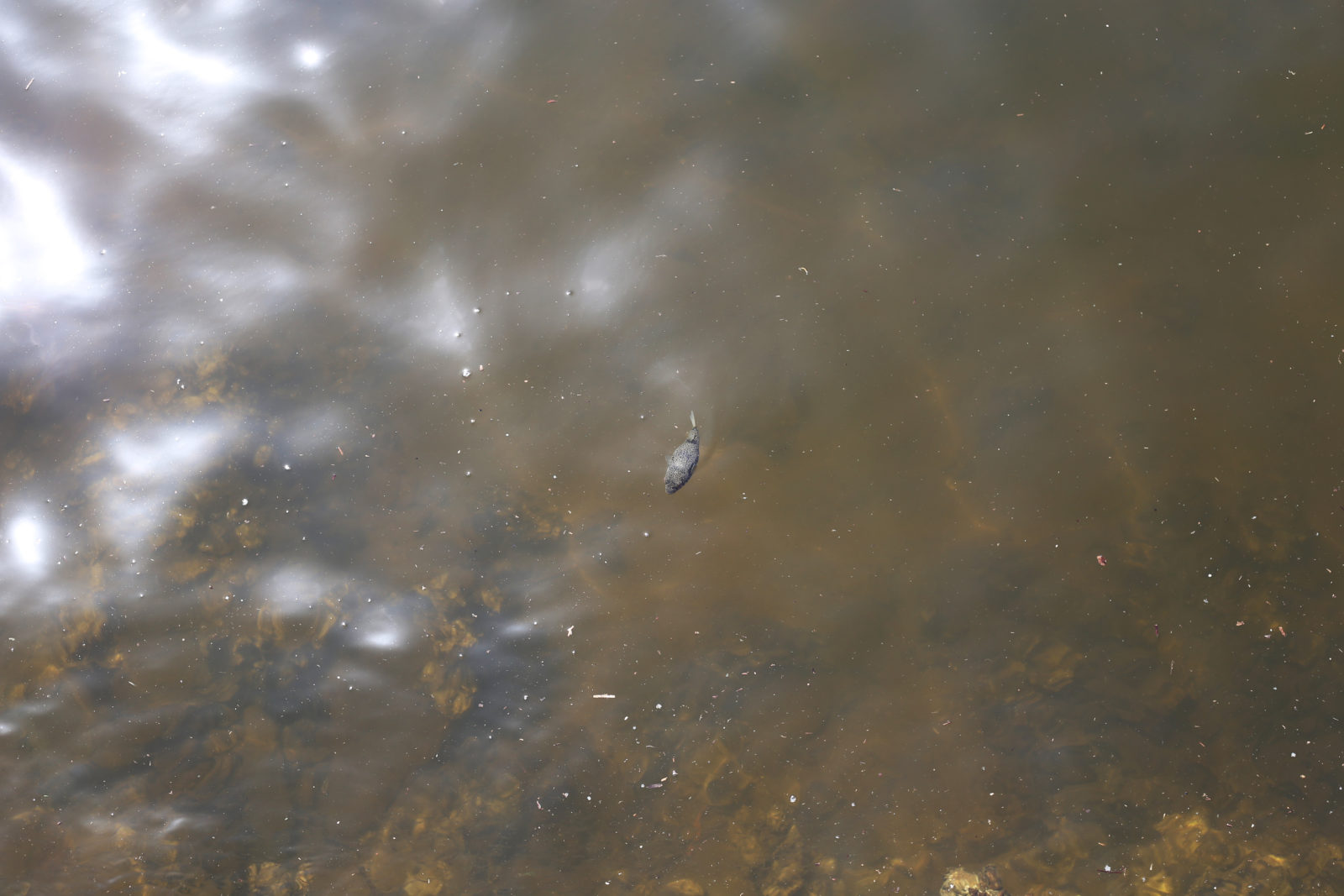
Artistically engaging with the materiality of place
Sampling polluted sediment after a heavy storm. Photo by Alexandra van der Eijk © All rights reserved
The artistic practice, even though it might at times borrow from scientific methods, as a core activity explores the concept of worlding and may be used to test alternative approaches towards knowledge creation and meaning making. Artistically investigating the materiality of a place requires attunement to the more-than-human actants: to understand their agency, their networked lives, and their physical and nonphysical presence. The investigation must begin by acknowledging the equality between entities, and maintain a radical openness to possibility: to never assume to really know what is taking place, nor feeling the need to know. It also requires the acknowledgement that all entities are inherently different and that knowing, or understanding, is often something that cannot be achieved. The artistic practice is a humbling practice which works to decentralize the anthropocentric vision, accepting what is over defining it. To intra-act with the materiality of place in the artistic practice is then to resist thinking of material’s use or function, and actively refuse the idea that value is only based on a materiality’s role in (human) progress. The fruits of this kind of practice are in creating space for other narratives to emerge. These narratives can tell a story that speaks to the complex and often feral processes taking place in the fluid borders between materialities.
The sediment cores of the Sydney estuary are a particularly interesting starting point for artistic research for three reasons: first, no obvious material interaction is observable with the naked eye. The cores’ materiality, though it shows some differences in color, is made up of what would generally, by the layperson, be considered “dirt.” Second, through the build-up and preservation of sediment in strata, the cores allow material access to past times. Third, the existing analysis in scientific studies of these cores has focused primarily on assessing the values of copper, zinc, and lead. For these reasons, a single core was requested for artistic experimentation, and generously made available by the University of Sydney.
Prioritizing attunement to matter over scientific fact, the artistic experiment with the harbor sediment was first entered without prior knowledge of the core analysis. Building on the hands-on, structural experimentation method of the Future Remnants project, the idea was to draw out the reactive components in the sediment with different (harmless) solvents, which would create the space and environment for them to reveal their nature. Additionally, the choice was made to work with different types of metal as a base for material experimentation: they form a basic reference to the industrial contamination, the scientific focus on the values of heavy metals, and the anthropogenic structures inhabiting the banks and waters of the estuary. The whole process, like in the Future Remnants project, serves as a reenactment of a speculative but probable scenario, as all elements used in the experimentation process are already, in some form, present in Sydney Harbour’s sediments and ecosystem.
Mixing samples with solvents before application. Photo by Alexandra van der Eijk © All rights reserved
The Blackwattle Bay core was sampled in four sections to experiment with the idea that, as different contamination sources came and went, the reactive agents in the sediment are specific to each time period. This led to the hypothesis that each section would produce a different result. The four samples were not matched with the samples that were taken for scientific analysis; instead, they were selected on careful observation, attention paid to color and density changes, the presence of other traces such as pieces of shell and anything else that stood out. Then, a baseline test was carried out where the solvents alone were applied to metal, in order to make sure the later experimental results were produced only by the reactive agents in the sediment.
Set of baseline tests, resulting in minimal verdigris effects. Photo by Alexandra van der Eijk © All rights reserved
Though the artistic experiment that followed did not revolve around the scientific analysis of the core, reviewing the papers and analysis contextualized some interesting insights.
For instance, the core used for this artistic experiment, labeled “Core 8, Pyrmont/Blackwattle, Birch & Lean, 15/8/13,” was serendipitously not described in any of the related (published) scientific papers. While it is possible that the core was renamed to JCL8 and cited as such, this code was referred to only twice: once on a map, and once in a general comment.16 The heavy metal values of two reviewed cores located near core JCL8, one deeper into Blackwattle Bay (labeled Core BL, obtained in 2004) and one in Rozelle Bay (labeled Core RB, obtained in 2013) are as different as night and day.17 After carefully reviewing the metal data, it was evident that exact concentrations across the bay vary meter to meter. Thus the basic idea of producing exact values for a place, like Blackwattle Bay, is simply not viable: exact metal profile values only describe the small pieces of sediment (roughly five by three centimeters) extracted for analysis from a sediment core. The point of emphasizing this limitation is not to sow doubt about the accuracy of scientific measurement—it is to establish awareness of what it means, practically, to conduct scientific research, and to stress that it generates a very specific kind of knowledge. It can’t be assumed that Core BL or RB would have similar values to Core 8’s metal profiles, or that Core 8 would show values somewhere in between those of BL or RB. Any data for Core 8 could simply not be retrieved. The materiality of this specific core has presently only been interpreted through the artistic experiment described here. This gives an open-ended invitation to all reactive actants present in the sediment to respond, without limiting what this response is or how it might be interpreted. This method may serve as an alternative knowledge-creating process to the scientific analysis resulting in the values of copper (Cu), lead (Pb), and zinc (Zn).18
Selection of results
Only a selection of the hundreds of tests of this process can be described here. Complimenting artistic practice with existing scientific knowledge, the estimated dates of the sediment samples are mentioned, as well as the metal profiles from the two adjacent cores (BL and RB) in the descriptions.
The threshold for trace metals in freshwater sediments in Australia and New Zealand for Cu is 65μg/g, for Pb 50μg/g and for Zn 200μg/g (ANZECC & ARMCANZ, 2000). Metal values in Blackwattle/Rozelle Bay lie between 150 μg/g and 6000 μg/g, high above what is considered safe levels by Australian law.
Sample D: est. 1930–1940
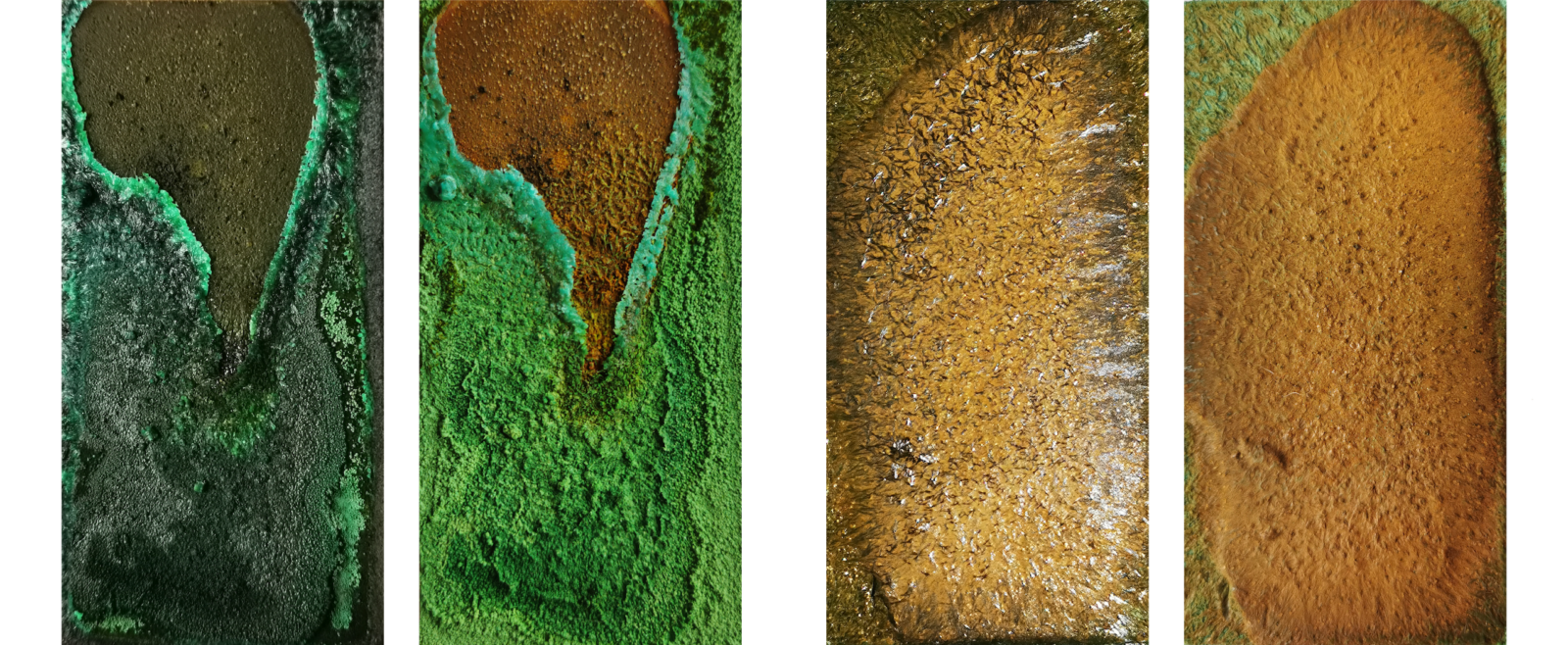
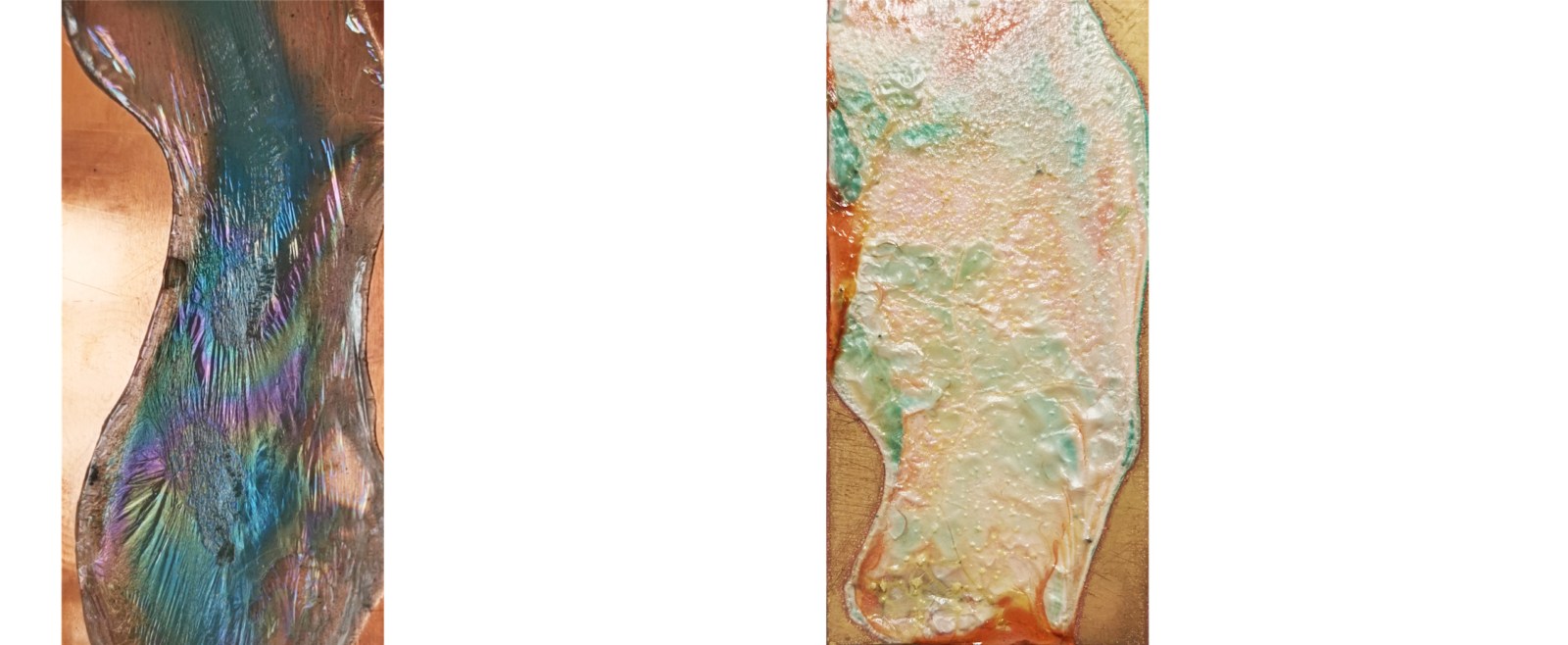
The dominant pollutant at this depth in core BL is Zn (est. 500μg/g), closely followed by Cu (est. 400μg/g) and a much smaller amount of Pb (est. 150μg/g). The dominant pollutant at this depth in core RB is Zn (est. 1000μg/g), closely followed by Pb (est. 600μg/g) and finally Cu (est. 150μg/g).
Sample C: 1960–1970
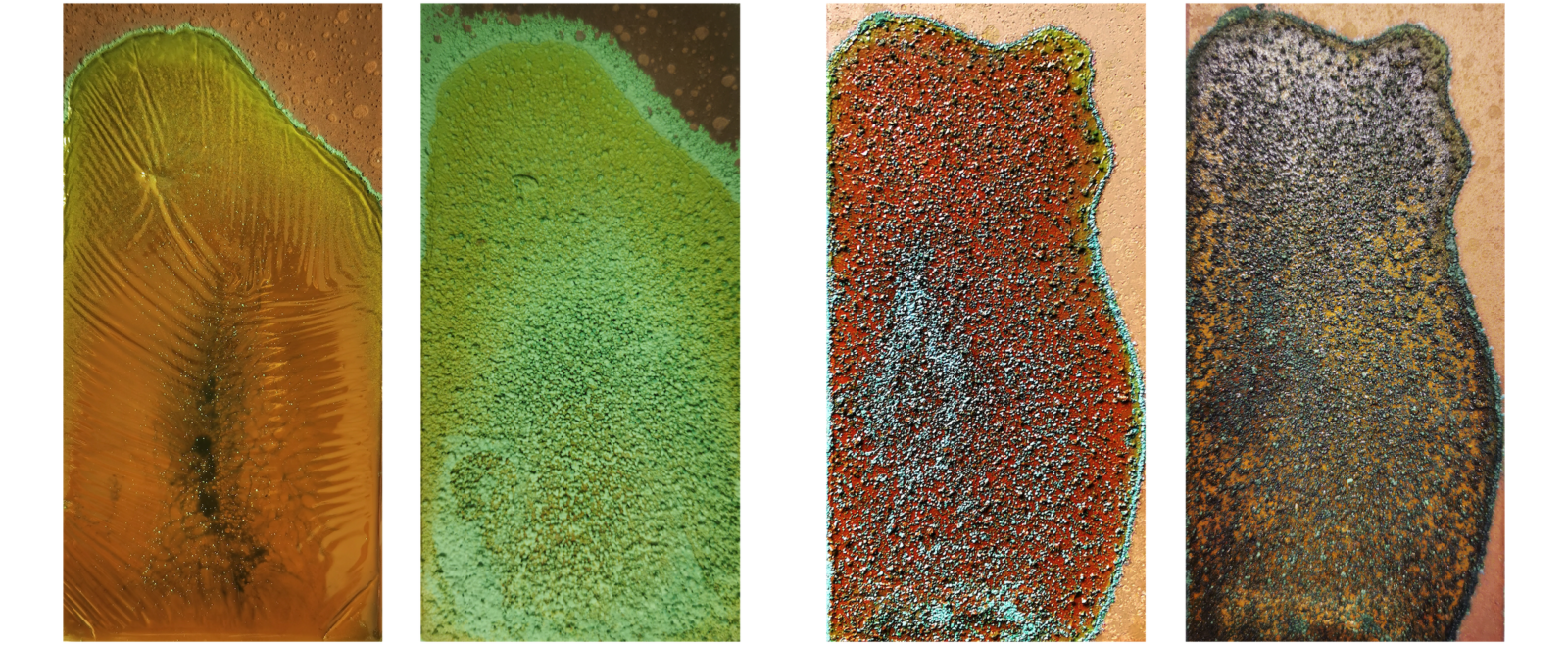
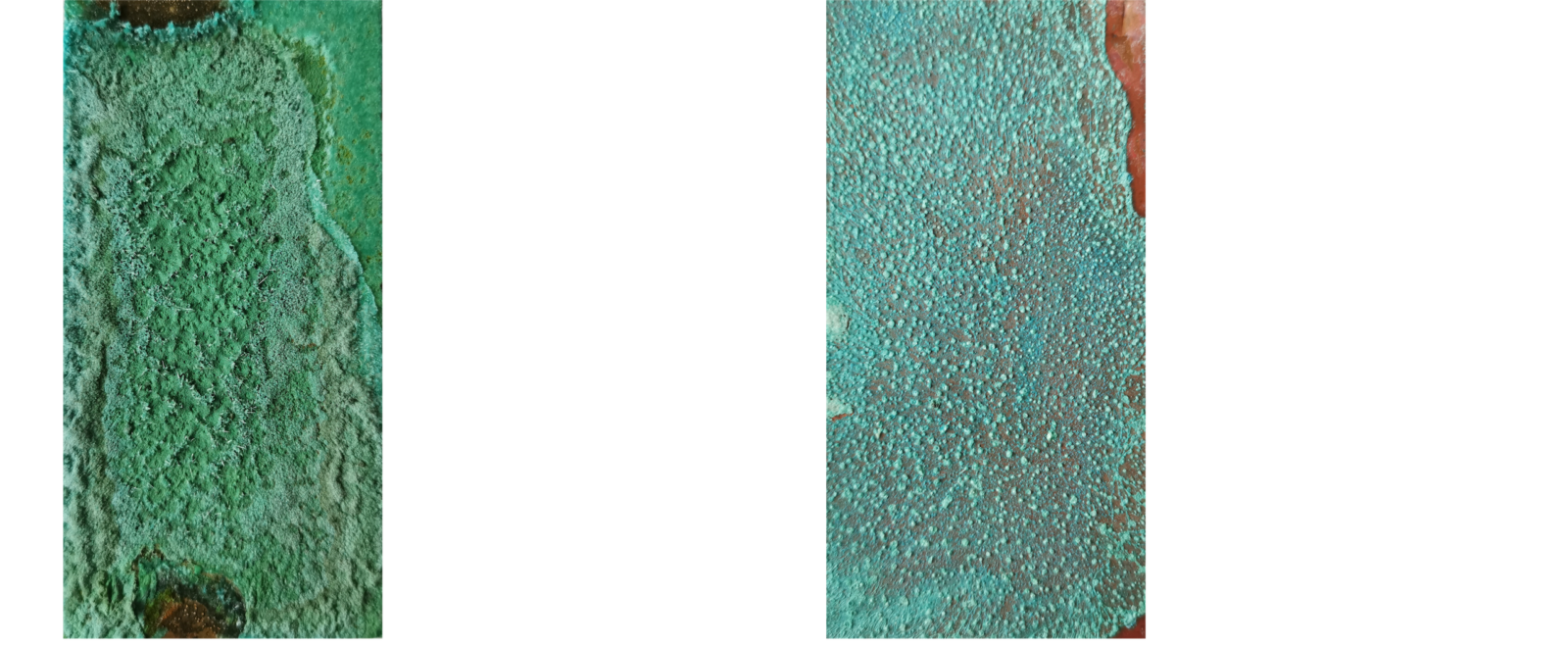
The dominant pollutant at this depth in core BL is Zn (est. 750μg/g), closely followed by Cu (est. 600μg/g). In 20 years, the contamination has increased significantly. Levels of Pb have remained the same (est. 150μg/g). The dominant pollutant at this depth in core RB is Zn (est. 6000μg/g), followed at distance by Pb (est. 2000μg/g) and Cu (est 1000μg/g).
Sample B: 1975–1985
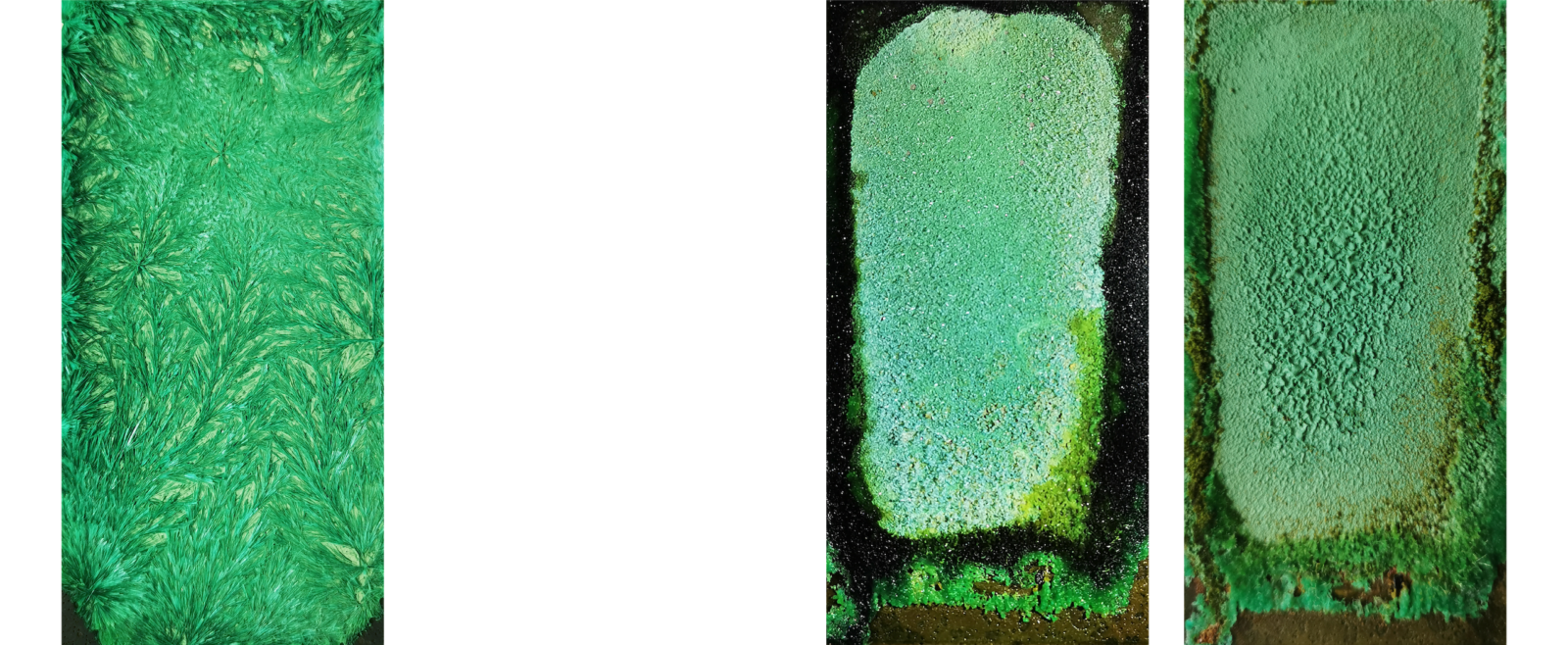
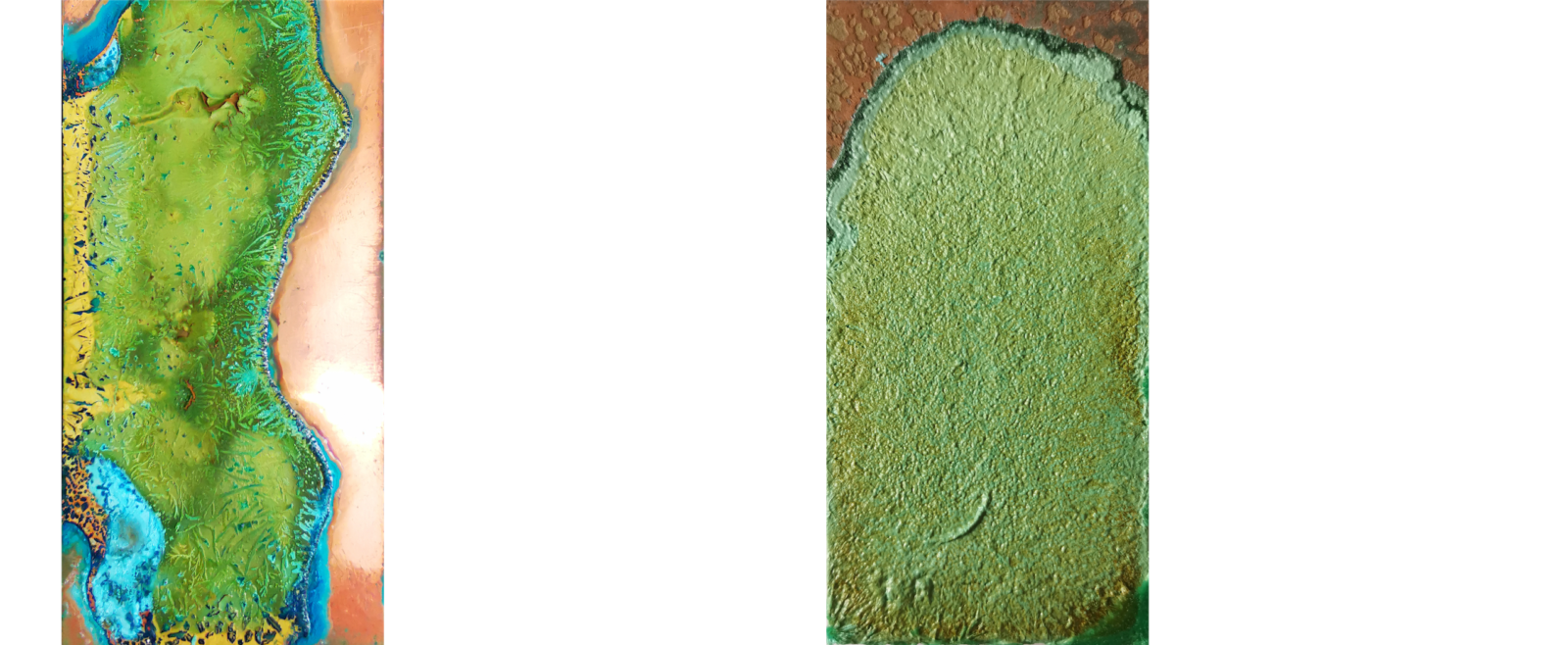
The dominant pollution at this depth in core BL is Zn (est. 1800 to 2200μg/g), with contamination at its absolute height and leaving a major gap with the other two metals. Though Cu remains constant (est. 600μg/g), the other peak is seen in Pb, increasing from est. 150μg/g to est. 500μg/g in 5 to 10 years. The dominant pollutant at this depth in core RB is Zn (est. 4400μg/g,), though it is declining at this time, with a small increase of Pb (est. 2200μg/g) and small decline of Cu (est. 700μg/g).
Sample A: 1990–2000
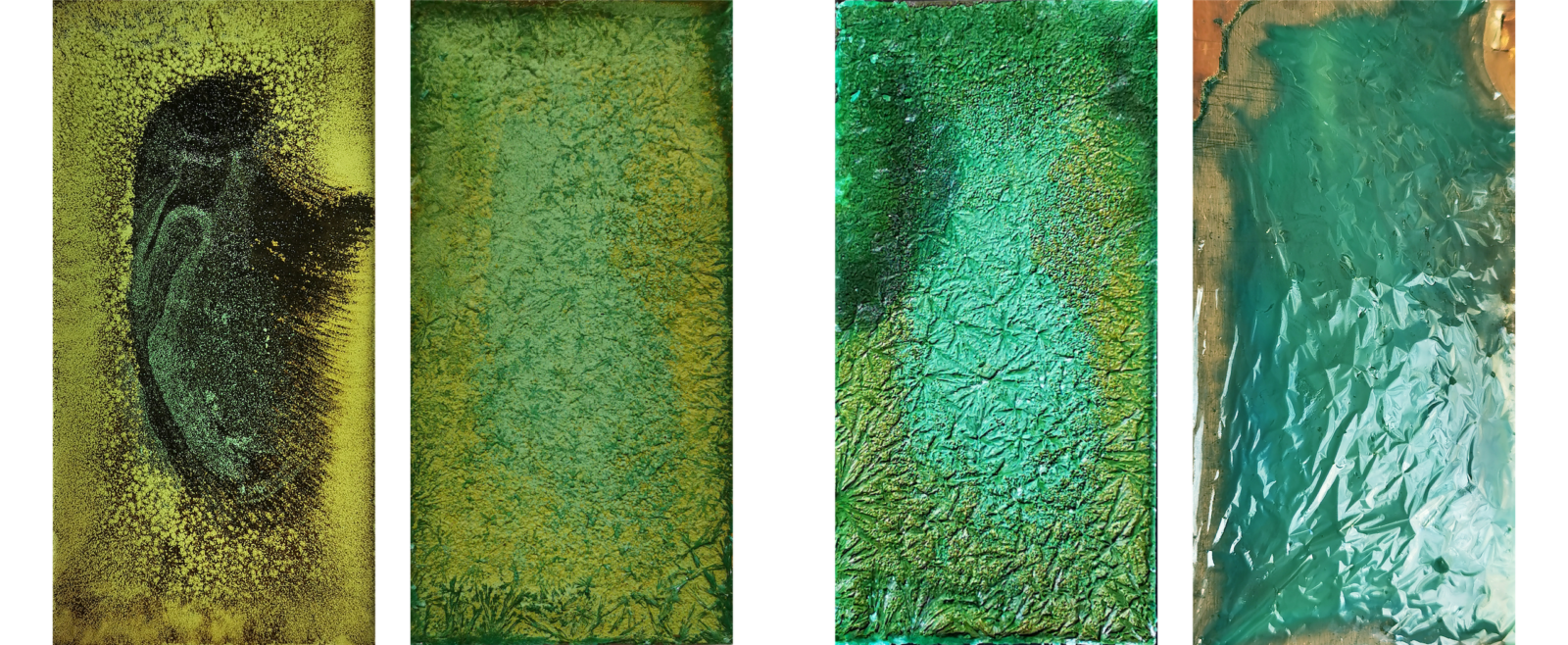
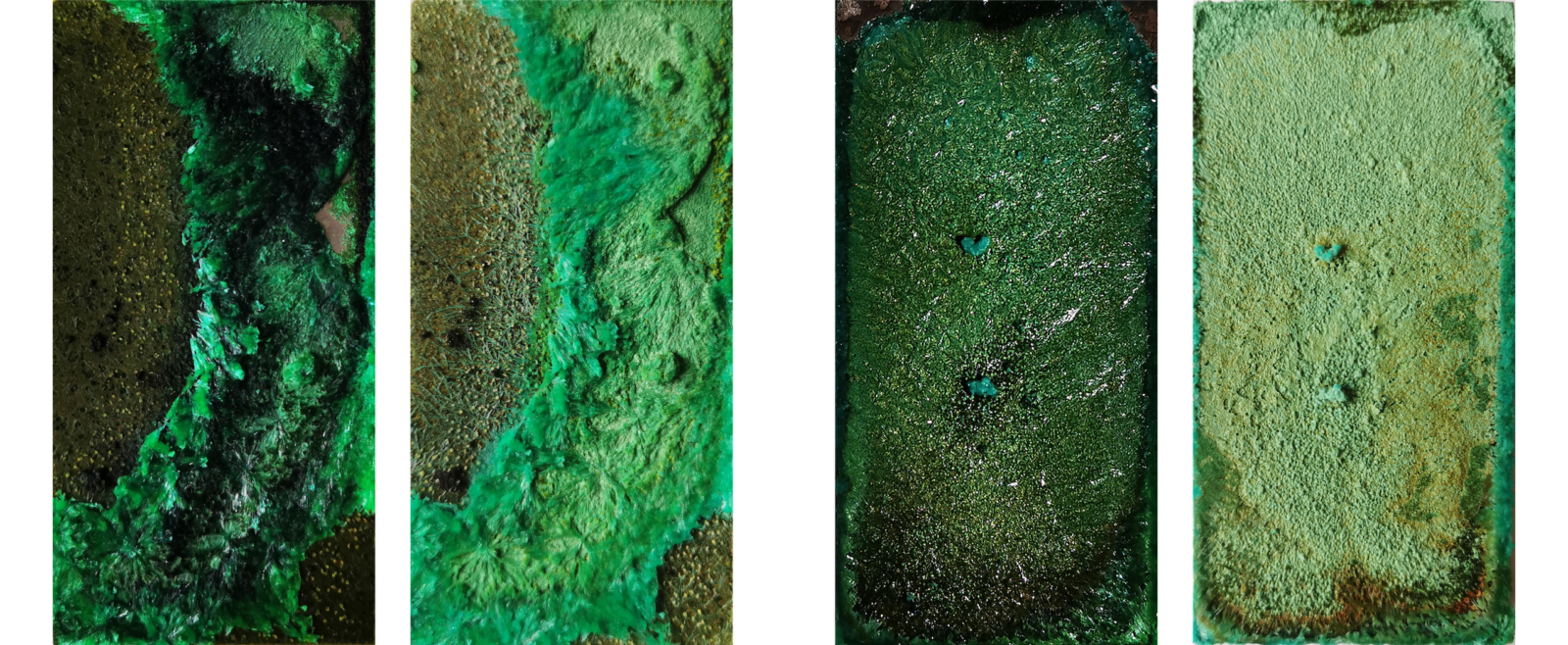
A decline in contamination is observed in all metal values, though values are still higher than pre-1975 levels. Zn remains dominant (1300μg/g), Cu slightly declining (500μg/g), and Pb remaining the same (500μg/g). The dominant pollutant at this depth in core RB is Zn, first rapidly decreasing, then sharply rising to est. 3600μg/g. Pb shows the same pattern, though with substantially lower values fluctuating around est. 1900μg/g) and a small decline of Cu (est. 600μg/g).
This experiment was set out to explore the question “Can the artistic practice uncover the lively encounters between vibrant materialities?” Comparing the baseline tests with the experiment results, it must be concluded that the sediment samples are indeed, above anything else, lively and vibrant. Samples changed immensely over time, shapeshifting between colors, textures, and crystallizations. While some finished their process within a day, others kept on “performing their nature” for weeks on end. The otherwise dull-looking “dirt” unfolded its powerful, violent voice in colors and textures fitting for toxicity. As a human interactor and facilitator, not knowing what forces were at work, what fumes the reactions might be producing, and understanding that the aesthetically pleasing crystals could quite possibly be harmful created a strong sense of unease. Undoubtedly, Blackwattle Bay has now become a part of my body.
Whereas the University of Sydney team tested the cores for specific heavy metals (copper, lead, and zinc) at different depths, the artistic experimentation was directed towards a holistic investigation of the sediment. Understanding the sediment as a whole does not rule out the potential narrative and agency of material interaction between the many different contaminants that were deposited. Rather than demonstrating what levels of specific contaminants are present in Blackwattle Bay, the experiments show there is some thing in the sediment of Blackwattle Bay. In separating sections of the core, it furthermore shows that at different depths, at different times, different some things were present. This does not eliminate the possibility that things from one time period interacted with another, and it does not put a limit on what any thing potentially mutates into. The process developed here works to visually uncover a hint of the actants in the sediment at work, without wanting to identify them or assuming to have gained any “real” knowledge on them. It simply demonstrates that the actants represent a uniquely storied matter, that, when given the space, can voice its own existence and character.
Whatever else is present in the sediment of Sydney estuary remains unheard, unseen, and untested for. The lively encounters between materialities and the feral character of the pollution caused by colonialism, industrialization, and capitalist modes of production are not generally recognized or researched by the environmental sciences. Both Future Remnants and the artistic investigation of Core 8 serve to open the conversation on how the artistic practice can contribute to creating knowledge in this field. Artistic experimentation applied with scientific rigor functions to enact a speculative reality, balancing on the thin line between fact and fiction, creating probable and tangible scenarios while exploring the open, porous boundaries between matter, place, and body.
Acknowledgements
The Sydney estuary project originally came to life as a public art commission from Mirvac, curated by Lou Weiss at Broached Commissions.
The sediment core of Blackwattle Bay was acquired with the kind assistance of Dr. Ana Vila Concejo and Tom Savage, and contextualized with the generous help of Dr. Gavin Birch at the University of Sydney.
Xandra van der Eijk is an artist researching the influence of the technosphere on evolutionary processes. With a distinct artistic-scientific methodology, she decentralizes the anthropogenic perspective by re-interpreting a landscape through its materiality.
Please cite as: Van der Eijk, X (2022) Visualizing the Vibrant Materiality of Place. Artistic Experiments on Polluted Sediment and the Anthropogenic Evolution of Minerals In: Rosol C and Rispoli G (eds) Anthropogenic Markers: Stratigraphy and Context, Anthropocene Curriculum. Berlin: Max Planck Institute for the History of Science. DOI: 10.58049/hp89-qm02
